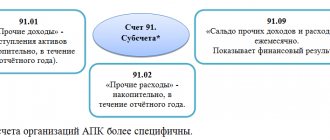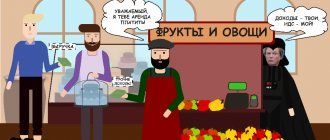What is non-operating income?
Non-operating (other) income is those incomes that are received from others not related to the main activities.
For example, a company is engaged in trade and simultaneously rents out storage space. Rental income will be classified as non-operating, and the costs of maintaining the warehouse will be classified as other costs. Non-operating income is taken into account when calculating tax profit, and their list is given in Art. 250 Tax Code of the Russian Federation .
For more information about what relates to non-operating income from the point of view of tax legislation, see the material “What is non-operating income according to Art. 250 of the Tax Code of the Russian Federation."
In accounting, non-operating income is taken into account as part of other income, since starting from the reporting for 2006 in connection with the adoption of the Ministry of Finance's order No. 116n dated 18/09/06, dividing income (practicum) into non-operating, operations new and emergency ones were abolished.
The list of other income is enshrined in clause 7 of PBU 9/99 and is open. These include, in particular:
- Income from the rental of company property.
- Exchange differences.
- Penalties (fines and penalties) received for non-compliance with contractual obligations.
- Property received free of charge.
- Proceeds from the sale of certain types of assets.
- Interest on credit agreements and bank deposits.
- Capitalization of surpluses identified during the inventory.
- Income from participation in management companies of other companies.
- Other income.
Let's consider the basic principles of organizing the accounting of other income.
Free use of the founder’s property
The founders often help their company with the property necessary for its work. Fixed assets are transferred to the company both for ownership and for temporary use. There are no problems with the first option: the company does not generate income if it receives ownership of property from the founder, whose share in the authorized capital exceeds 50% (clause 11, clause 1, article 251 of the Tax Code of the Russian Federation). This provision does not say about obtaining property rights.
The Presidium of the Supreme Arbitration Court of the Russian Federation established that by using someone else’s property for free (no matter that it was provided by the founder with the “correct” share in the authorized capital), the company receives a property right, which is already taxable income of the organization (information letter of the Supreme Arbitration Court of the Russian Federation dated December 22, 2005 No. No. 98).
This was confirmed by the Russian Ministry of Finance (letter dated April 19, 2006 No. 030304/1/359). The amount of such income is equal to the market rental price of similar property.
However, there is a way to avoid paying income tax on property rights received free of charge.
Since judges and officials have equated free use to free rent, then it is necessary to establish rental payments in the agreement between the founder and the company. That is, enter into a regular lease agreement. And the founder can return the received rental payments to the company, but in the form of money. After all, the norm prescribed in subparagraph 11 of paragraph 1 of Article 251 of the Tax Code of Russia does not apply to funds. The money received does not need to be included in income.
Note:
There is no need to mention any return “on paper”. Receiving money from the founder should be formalized as financial assistance. Moreover, payments under the lease agreement and financial assistance should not be related to each other.
As a result, the company, without increasing its income, will receive the necessary property, include rent as an expense, and then return all the money paid to the founder (this does not lead to the formation of taxable income).
note
: the founder’s share in the authorized capital of the company must exceed 50%.
Example
In 2009, a company received office equipment for rent from its sole founder. The market rental price was RUB 50,000. The company took into account the entire amount of rental payments as expenses. The founder provided financial assistance to the company in the amount of 50,000 rubles. Since he owns a share amounting to more than 50% of the company’s authorized capital, there is no need to charge income tax on the amount of financial assistance. The real savings on income tax for the company will be 20,000 rubles. ((RUB 50,000 + RUB 50,000) × 20%).
When paying lease payments, personal income tax must be withheld. Tax must be withheld directly from the lease payments when they are paid. Read more about this in the Berator section “ Personnel. Salary
».
Note:
When drawing up the terms of the transaction, it is necessary to take into account the requirements of Article 40 of the Tax Code of Russia - the amount of rental payments must correspond to market prices.
Accounting for non-operating income and expenses in accounting and tax accounting
To display information about other income and expenses, account 91 is intended, to which the corresponding sub-accounts are opened: 1 - for accounting for income and 2 - for accounting for expenses of the enterprise (Order of the Ministry of Finance dated October 31, 2000 No. 94n). Accounting for transactions on other income and expenses is carried out in the above-mentioned sub-accounts cumulatively throughout the year, at the end of which they are closed to sub-account 91.9 “Balance of other income/expenses” by internal transactions.
At the end of each month, the difference between the final balance of subaccounts 91.1 and 91.2 final turnover is written off from subaccount 91.9 to account 99 “Profit/loss”. That is, account 91 does not have a balance at the end of the month.
For correspondence of accounts and al ٜ go ٜ ri ٜ tm accounting of other to ٜ ho ٜ to ٜ in and expenses , see article ٜ at ٜ ye “Accounting for other income and expenses (nuances)”.
Analytical accounting is organized for each type of income and expense with the ability to display the financial result for each operation.
Tax accounting of non-operating income (expenses) has its own characteristics and differences from accounting.
ConsultantPlus experts explained how to take into account non-operating income when calculating income tax. If you don't have access to the system, get a free trial online.
Account 91 - active or passive
Account 91 belongs to the category of mixed, or active-passive. It simultaneously takes into account both assets and liabilities. And its balance is changeable - it can only be debit or only credit.
On credit 91 accounts during the month reflect income from other sources, and on debit - other expenses. At the end of the month, the debit and credit turnovers are compared, the smaller is subtracted from the larger and the result is obtained. If the balance turns out to be a credit balance, income exceeds expenses, and the company generates profit from other activities. If it's the other way around, it's a loss.
There should be no balance left in the account at the end of each month. It is written off to the Profit and Loss account.
Results
Accounting for non-operating income is carried out in account 91.1 “Other income”, expenses - 91.2 “Other expenses”.
Tax legislation provides for certain conditions for determining non-operating income and expenses that differ from accounting ones. The consequence of these differences is the emergence of tax obligations and the need to maintain additional tax registers. You can find more complete information on the topic in ConsultantPlus. Free trial access to the system for 2 days.
Cost areas
All expenses of an organization that can be classified as non-operating are taken into account when determining the amount of income tax separately. Each of these areas of costs is presented in Article 265 of the Tax Code of the Russian Federation. Let's look at them further in the list.
- Maintenance of material property objects leased.
- Interest paid on various loans and credits.
- Negative difference between exchange rates.
- Cash contributions to the reserve for doubtful debts.
- Expenses incurred during litigation.
- Expenses spent on paying for the services of a credit institution. Sometimes this item is mistakenly attributed to indirect costs, but this is not the correct approach, since they are non-operating expenses.
If the company sued someone to defend its honor, then the costs taken into account as legal costs will be classified as non-operating, since they were necessary for the company, but did not relate to the production or trade process
- Losses incurred during previous annual operating periods that were discovered directly in the current reporting period.
- The amount of debts considered bad that are not covered by the reserve created to pay off doubtful debts.
- Shortages in inventories can also be included in this list, but only if the person responsible for their formation could not be identified, and, as a result, it was not possible to recover compensation from him.
- Losses incurred as a result of force majeure circumstances, as well as emergency situations.
- Monetary losses that occurred at the time of concluding an agreement on the assignment of the right of claim.
Extract from the Tax Code of the Russian Federation Article 265. Non-operating expenses
This list is designated, as we have already said, by the Tax Code of our country. However, this does not mean that it cannot be replenished with new items. On the contrary, the legislator admits and accepts that the tax base will begin to reflect other non-operating expenses that are not directly listed in the list.
Accounting
Non-operating expenses are recorded in account 91 “Other income and expenses”, subaccount 91-2 “Other expenses”.
Income
In accounting, the concept of other income is given in PBU 9/99 “Income of the organization.” Chapter 3 “Other Income” gives a specific list of main income, expanding it with the last paragraph “other income”. The most common ones in accountant practice are:
- income from the sale of fixed assets,
- interest on loans provided,
- gratuitous receipts,
- damage payments (for example, proceeds from insurance companies),
- losses from previous years
- exchange differences,
- amounts of bad accounts payable that cannot be recovered due to any circumstances.
The last paragraph “other income ” makes it possible to include in this type of income other income not listed above. For example, these could be serviceable spare parts obtained from dismantling worn-out equipment, or surplus goods identified during inventory. Naturally, it is necessary to provide for these types of income as other types of income in the accounting policy.
For example, an organization whose main activity is wholesale trade has income from renting out vehicles or premises. In this case, this type of income must be taken into account as other income. But these incomes will not be other income for an organization that is engaged only in leasing property, and this is its main activity.
Let's look at a few of the most common examples:
- proceeds from a property lease agreement
| No. | Contents of operation | Corresponding accounts | Amount (rub.) | |
| Debit | Credit | |||
| 1 | Accrued income from rental property | 76-05,62-01 | 91-01 | 16949,15 |
| 2 | VAT is charged on income from rental property | 91-02 | 68-02 | 3050,85 |
| 3 | Receipt from the tenant | 50-01, 51 | 76-05 | 20000,00 |
- income from the sale of a fixed asset with a useful life of 5 years after 4 years of use
| No. | Contents of operation | Corresponding accounts | Amount (rub.) | |
| Debit | Credit | |||
| 1 | The buyer's debt for the fixed asset has been accrued | 76-05,62-01 | 91-01 | 118000,00 |
| 2 | The fixed asset is written off from the balance sheet at its original cost | 01-09 (disposal of fixed assets) | 01-01 | 70000,00 |
| 3 | Depreciation written off for 4 years | 02-01 | 01-09 | 60000,00 |
| 4 | The residual value of the fixed asset is written off | 91-02 | 01-09 | 10000,00 |
| 5 | VAT is charged on the amount of sale of fixed assets | 91-02 | 68-02 | 18000,00 |
| 6 | Receipt of funds from the buyer to the bank account | 51 | 76-05,62-01 | 118000,00 |
| 7 | The balance of the 91st account is written off to the 99th account - profit is reflected | 91-01 91-09 | 91-09 99-01 | 90000,00 90000,00 |
Typical entries for other, less complex transactions are as follows:
| No. | Contents of operation | Corresponding accounts | |
| Debit | Credit | ||
| 1 | Interest accrued | 66-04 | 91-01 |
| 2 | A penalty was assessed for violation of the terms of the contract, assets were received free of charge | 76-05 | 91-01 |
| 3 | Compensation for losses by an insurance company | 76-01 | 91-01 |
| 4 | Profit of previous years identified in the reporting period | Miscellaneous accounts | 91-01 |
| 5 | Bad accounts payable written off | 60-01,76-05 | 91-01 |
| 6 | Exchange rate difference accrued | 62-01,60-01 | 91-01 |
In tax accounting, Article 250 of the Tax Code of the Russian Federation “Non-operating income” is responsible for determining other income.
Unlike other accounting income, the list of non-operating income is more extensive, but closed .
That is, if you are faced with something that is not listed in Article 250 of the Tax Code of the Russian Federation, it means that this is income from your main type of activity. There are simply no other options.
In most cases, there is no difference when determining the amount of income for accounting and tax purposes. But such differences are possible , here are examples of their possible occurrence:
- when selling a fixed asset with different monthly depreciation amounts (there was a modernization);
- sale of fixed assets with different initial costs (in the case of a leasing agreement, for example);
- when positive amount differences occur that do not take place in accounting.
Expenses
Chapter 3 of PBU 10/99 “Other expenses” tells us about other expenses. The list of expenses there is not large, but it is not closed . At its discretion, the organization itself may include certain types of expenses that, in its opinion, are classified as others.
These may be expenses that occur, but are not designated in the PBU as expenses for ordinary activities. An example of such an expense is property tax. It is not listed in the list of expenses for ordinary activities, and is also not included in the list of other expenses, so the company, at its discretion, can take it into account as a other expense. The same applies to government duties.
Most often you may encounter other expenses such as:
- losses on the sale of fixed assets,
- interest on loans received,
- expenses for maintaining and servicing a current account,
- reserve for doubtful debts, which must be created by all organizations regardless of size,
- penalties for violation of contractual obligations, including late tax payments,
- losses recognized in the current year from previous years,
- amounts of expired accounts receivable,
- negative exchange rate differences.
Let's look at the most complex examples of accounting for other expenses:
- loss-making sale of a fully depreciated fixed asset:
| No. | Contents of operation | Corresponding accounts | Amount (rub.) | |
| Debit | Credit | |||
| 1 | The buyer's debt for the fixed asset has been accrued | 76-05,62-01 | 91-01 | 118000,00 |
| 2 | The fixed asset is written off from the balance sheet at its original cost | 01-09 (disposal of fixed assets) | 01-01 | 130000,00 |
| 3 | Depreciation written off for 1 year | 02-01 | 01-09 | 26000,00 |
| 4 | The residual value of the fixed asset is written off | 91-02 | 01-09 | 104000,00 |
| 5 | VAT is charged on the amount of sale of fixed assets | 91-02 | 68-02 | 18000,00 |
| 6 | Receipt of funds from the buyer to the bank account | 51 | 76-05,62-01 | 118000,00 |
| 7 | The balance of the 91st account is written off to the 99th account - a loss is reflected | 91-09 99-01 | 91-02 91-09 | 4000,00 4000,00 |
- creating a reserve for doubtful debts and writing off accounts receivable from the reserve:
| No. | Contents of operation | Corresponding accounts | Amount (rub.) | |
| Debit | Credit | |||
| 1 | A reserve has been created for amounts of receivables recognized as doubtful for return | 91-02 | 63 | 100000,00 |
| 2 | The amounts of bad receivables were written off based on the decision of the PSP to terminate enforcement proceedings due to the impossibility of collecting the debt | 63 | 62-01 | 50000,00 |
| 3 | The debtor paid off the debt | 51 | 62-01 | 50000,00 |
| 4 | The reserve for doubtful debts was restored in connection with the repayment of the debt by the debtor | 63 | 91-01 | 50000,00 |
Typical entries for accrual of common other expenses:
| No. | Contents of operation | Corresponding accounts | |
| Debit | Credit | ||
| 1 | Interest accrued on loans received | 91-02 | 66-04 |
| 2 | Bank expenses included | 91-02 | 51 |
| 3 | Accrual of fines for violation of contractual obligations | 91-02 | 76-02 |
| 4 | Losses from previous years recognized | 91-02 | Miscellaneous accounts |
| 5 | Negative exchange rate differences accrued | 91-02 | 60-01,62-01 |
In tax accounting, these expenses are defined in Article 265 “Non-operating expenses”. The list of them is very wide, but just like the list of non-operating income, it is closed .
Basically, the list of non-operating income includes items of other accounting expenses. But there are also some discrepancies. The list of other income not accepted for tax accounting as non-operating income is quite large; we will name only the most common ones that every accountant working with taxes needs to know:
- expenses for charitable, cultural and entertainment events,
- fines and penalties for taxes, contributions, payments transferred to the state budget,
- interest accrued to the creditor in excess of the amount limited by Articles 269 and 291 of the Tax Code of the Russian Federation.
Recognition of expenses as non-operating
The importance of attributing expenses specifically to this type of expense helps in reducing the tax base for income tax.
Write-off of expenses is carried out using one of two methods, and for each the Tax Code of the Russian Federation has its own procedure:
- When using the accrual method, you need to use clause 7 of Art. 272 Tax Code of the Russian Federation;
- for the cash method , the procedure described in paragraph 3 of Art. 273 Tax Code of the Russian Federation.
The moment of recognition of expenses depends on the choice of method: in the first case, this is the date of documentary confirmation of the basis, and in the case of using the cash method, the actual occurrence of the event.
It is necessary that expenses have mandatory documentary evidence; this requirement is clearly stated in the Tax Code of the Russian Federation. What kind of confirmation this will be will have to be decided on a case-by-case basis.
For example, when writing off as a non-operating expense losses from a fire that occurred in a given period, one of the documents can serve as confirmation:
- a certificate issued by the fire service (government body);
- report from the scene of the incident;
- act of establishing the cause of the fire;
- inventory acts, etc.







